Joshua Johnston (or Johnson) (1765 - 1830) "Portrait of a Gentleman" 1805 - 1810
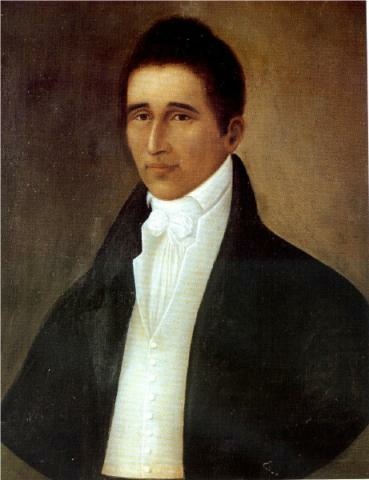
Believed to be a portrait of the Rev. Daniel Coker (1780 - 1846), one of the founders of the African Methodist Episcopal Church. In 1810, Coker published a pamphlet demanding universal emancipation, "A Dialogue between a Virginian and an African Minister." Johnston was probably in the elitist mulatto class (a hypothesis based on his paintings of black clerics) and also associated with affluent whites, some of whom were abolitionists.
From: Patton, Sharon F. Oxford History of Art - African-American Art. Oxford University Press: New York, 1998, 48.
Joshua Johnston (or Johnson) (1765 - 1830) "Portrait of a Gentleman" Oil on canvas 1805
Listed in 1796 and 1824 as a Joshua Johnston, "free householder of colour, portrait painter." He also painted children.
From: Coker, Gylbert. "Nineteenth - Century African American Art," The Harmon and Harriet Kelley Collection of African American Art. The University of Texas Press: Texas, 1994, 46.
Note: Harmon and Harriet Kelley have demanded that we not show images of any paintings they own.
Instead, See 5 paintings displayed by the National Gallery of Art.
See also: 1805 painting Edward and Sarah Rutter at the Metropolitan Museum and 3 paintings at the Fine Arts Museums of S.F. and the Chrysler Museum of Art shows "Mrs. Abraham White and Daughter Rose."
Grace Allison McCurdy and Her Daughters at the Corcoran Gallery
The Smithsonian shows 3 portraits. and 3 more at the Maryland ArtSource
Joshua Johnston (or Johnson) (1765 - 1830) "The Westwood Children" Oil on canvas 1807
larger version: http://www.nga.gov/cgi-bin/pimage?45672+0+0
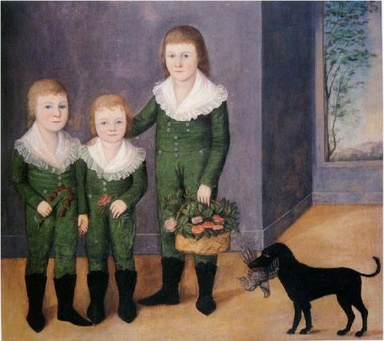
Johnson was one of the earliest African American visual artists to receive professional recognition. His career began in 1789 and was greeted with acclaim between 1796 and 1824. Characteristics of his art are sitters sitting at a three quarter's view, Sheraton chairs, elliptical eyes, elaborate collars, skirt fabrics and suits.
From: Britton, Crystal A. African American Art -- The Long Struggle. Todtri Productions Limited: New York, New York. 1996, 23.
other paintings
National Gallery of Art
Chrysler Museum
Corcoran Gallery of Art
Smithsonian American Art Museum
Maryland ArtSource
Edmonia Wildfire Lewis ( 1845 - 1900? ) "Death of Cleopatra" 1876

This work was exhibited in the Women's Pavilion at the Centennial Exposition in Philadelphia in 1876 with 600 other sculptures by various other artists, and caused a sensation due to the realistic portrayal of Cleopatra. The statue shows female power and vulnerability (power in the fact that Cleopatra was a femme fatale, and vulnerability in the fact that she is dead.) Lewis may be making reference to how Cleopatra was thwarted in her attempts for power, but in suicide she has control. Lewis was quoted by William Wells Brown in "The Rising Son" (1874): "I have a strong sympathy for all women who have struggled and suffered" (97).
From: Patton, Sharon F. Oxford History of Art - African-American Art. Oxford University Press: New York, 1998, 96.
Edmonia Wildfire Lewis ( 1845 - 1900? ) "Forever Free" Marble 1867
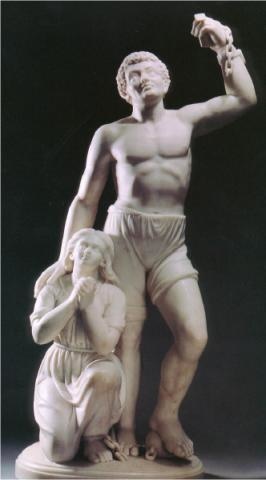
A third-generation African-American, Lewis was born with the name Wildfire, but changed it to Edmonia. She was the first African American woman to have an international career in the fine arts. Persecuted in art school and not allowed to graduate, she worked with abolitionists and opened a studio in Rome in 1865 from the money earned by a bust of Colonel Robert Gould Shaw. The sculpture is modelled on an engraving, "Am I Not a Man and a Brother," used in Abolitionist publications.
From: Britton, Crystal A. African American Art - The Long Struggle. Todtri Productions Limited: New York, New York. 1996, 31.
Other works
Smithsonian American Art Museum
Cleopatra Lost & Found
Grafton Taylor Brown (1841-1918), "The Iron-Clad Mine" Lithograph approx. 1880
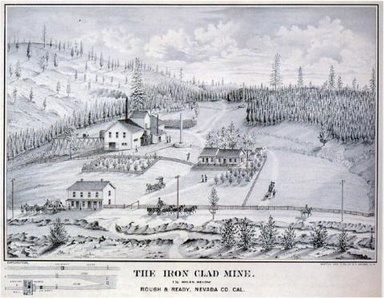
Brown was born in Harrisburg, Pennsylvania and lived in Pacific Northwest. Beginning in 1861 he was employed as a draftsman and lithographer by Charles Kuchelm and made lithographs of Northwest mountain landscapes, mining towns, stock certificates, letterheads, and sheet music. He opened own lithography business in 1867. He exhibited his works in 1883, and his works were praised for their beauty and fidelity to landscape. This is one such lithograph.
From: Guy C. McElroy et al. African - American Artists : 1880 - 1987. University of Washington Press: Seattle, Washington, 1989, 18.
Grafton Taylor Brown (1841 - 1918) "Yosemite Falls" Oil on canvas 1888
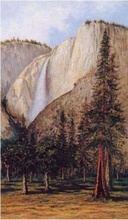
The flatness and static nature of this painting likely derives from Brown's lithographic style.
From: Guy C. McElroy et al.. African - American Artists : 1880 - 1987. University of Washington Press : Seattle, Washington, 1989, 19.
A biography and photo portrait is available at the Schomburg Center for Research in Black Culture
Harriet Powers ( 1837 - 1911 ) "Bible Quilt" 1886
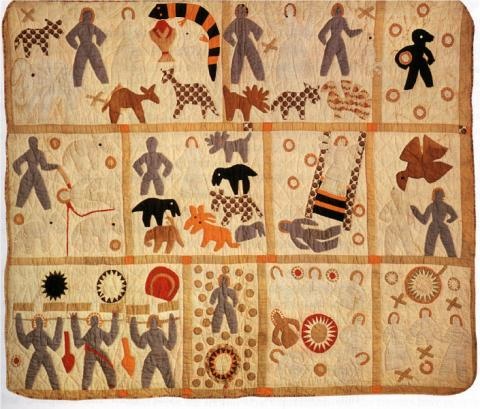
The quilt has faded considerably - the light tan was once deep pink and the yellowish brown borders were once green. Panels in quilt show spiritual stories, and were a way for the illiterate Powers to preserve her memories. Among the scenes depicted are Noah and the art, and Jacob and the ladder.
From: Patton, Sharon F. Oxford History of Art - African-American Art. Oxford University Press: New York, 1998, 69.
Harriet Powers (1837 - 1911) "Bible Quilt" 1898
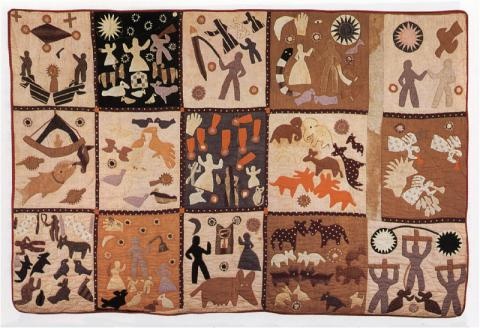
The images in this quilt are from local parables and stories. Panel 8 (dark blue with yellow stars): "The falling of stars on November 13, 1833. The people were frightened and thought the end of time had come. God's hand staid the stars. The varmints rushed out of their beds." (70)
From: Patton, Sharon F. Oxford History of Art - African-American Art. Oxford University Press: New York, 1998, 70.
Henry Ossawa Tanner (1859 - 1937 ) "The Banjo Lesson" Oil on canvas 1893
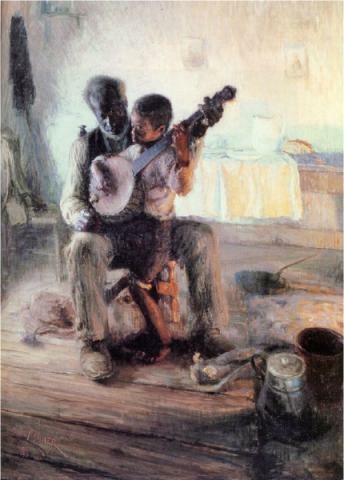
Tanner moved to France to escape racism. He spoke on "The American Negro in Art" at World's Columbian exposition in Chicago, and "claimed that actual achievement proved Negroes possess ability and talent for successful competition with white artists" (8). This speech influenced his art, and he started a series of genre paintings to combat stereotypes. This is one image from that series.
From: Britton, Crystal A. African American Art - The Long Struggle. Todtri Productions Limited: New York, New York. 1996, 33.
Other paintings
The Art Institute of Chicago
Smithsonian American Art Museum
Henry Ossawa Tanner (1859 - 1937 ) "Head of a Girl in Jerusalem (The Artist's Wife)" Oil on artist board 1899
Note: Harmon and Harriet Kelley demanded that we not display an image of this painting which they own so we have removed our copy. You can view it here.
From : Coker, Gylbert. "Nineteenth - Century African American Art." The Harmon and Harriet Kelley Collection of African American Art. The University of Texas Press : Texas, 1994, 24.
William A. Harper ( 1873 - 1910 ) "Landscape with Poplars (Afternoon at Montigny)" Oil on canvas 1898
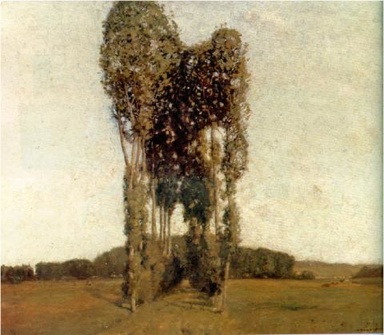
Acclaimed as a rising talent, Harper died at only 37. He was influenced by the Barbizon school of naturalist painters who focused on atmosphere and attention to detail.
From: Britton, Crystal A. African American Art - The Long Struggle. Todtri Productions Limited: New York, New York. 1996, 18.
Nelson Primus (1843 - 1916? ) "Portrait of a Lady (Lady with Golden Hair)" Oil on canvas 1907
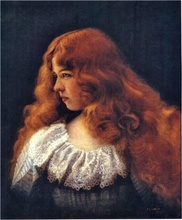
His success was more limited than that of Bannister, and much of his work is lost.
From : Guy C. McElroy et al.. African - American Artists : 1880 - 1987. University of Washington Press : Seattle, Washington, 1989, 21.
Henry Ossawa Tanner (1859 - 1937) "The Visitor" Pastel on paper 1910
He moved to France to escape racism. He spoke on "The American Negro in Art" at World's Columbian exposition in Chicago, and "claimed that actual achievement proved negroes possess ability and talent for successful competition with white artists" (8). This speech impacted his art, and he started a series of genre paintings to combat stereotypes.
From: Coker, Gylbert. "Nineteenth - Century African American Art." The Harmon and Harriet Kelley Collection of African American Art. The University of Texas Press : Texas, 1994, 9.
Note: Harmon and Harriet Kelley have demanded that we not show images of any paintings they own.
There are no copies of this painting on the Web but there are many others available.
Other Tanner paintings on the Web
The Art Institute of Chicago
Smithsonian American Art Museum
Edwin A. Harleston ( 1882 – 1931 ), "Portrait of a Woman" 1920
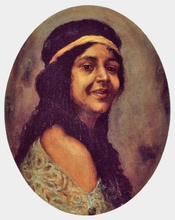
Harleston was known for sensitive realistic portraits of African Americans, especially of the working class. He received many awards, including an Amy Spingarn prize in 1924 for his portrait of his wife.
From : Barnwell, Andrea D. The Walter O. Evans Collection of African American Art. University of Washington Press : Seattle, Washington, 1999, 103.
Nancy Elizabeth Prophet (1890 - 1960), "Silence," Marble 1920-1930
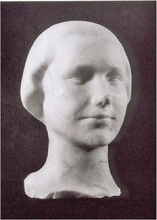
An early female artist, Prophet graduated from the Rhode Island School of Design and studied in Paris. Like many other African-American artists, musicians and writers of the period, she stayed in France for ten years, then returned to U.S. in 1934 and started a sculpture program at Spelman College in Atlanta, Georgia. Her subjects are almost always African American, and "embody a spirit of quiet pride and self respect."
From: Britton, Crystal A. African American Art - The Long Struggle. Todtri Productions Limited : New York, New York. 1996, 29.
See also:
Negro Head 1930
and
Congolais, 1931
Archibald J. Motley Jr. ( 1891 - 1981 ), "Mending Socks" 1924
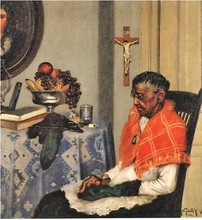
This is the artist's paternal grandmother, Emily Motley. This image and "The Octoroon Girl," according to the artist, are among his favorites. The portrait is a variation/parody of Whistler's portrait of his mother.
From: Patton, Sharon F. Oxford History of Art - African-American Art. Oxford University Press: New York, 1998, 121.
Archibald J. Motley Jr. ( 1891 - 1981 ), "The Octoroon Girl" 1925
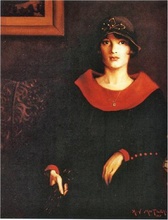
This image and "Mending Socks," according to the artist, are among his best. "The Octoroon Girl" is one of several "scientific" paintings examining light-skinned African-Americans, especially in Louisiana (the artist's birthplace). His works show a fascination with skin color and a desire to rebut stereotypes of African American female features.
From: Patton, Sharon F. Oxford History of Art - African-American Art. Oxford University Press: New York, 1998, 122.
Other paintings
The Art Institute of Chicago
Palmer Hayden (1893 - 1973) "Fétiche et Fleurs" (Fetish and Flowers), 1926
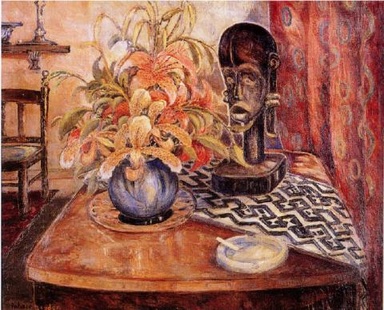
Fang reliquary sculpture and Kuba cloth were popular representations of African art in the USA and Paris. This image won the Harmon Foundation's Gold Medal for distinguished Achievement Among Negroes in Fine Arts in 1926. The painting strives to find a new racial art medium, and to adapt the genre of still life to Africana themes.
From: Patton, Sharon F. Oxford History of Art - African-American Art. Oxford University Press: New York, 1998, 120.
See Also:
Midsummer Night in Harlem, 1938
Nous Quatre a Paris, 1935
James Van DerZee (1886 - 1983) "Alpha Phi Alpha Basketball Team," Photograph 1926
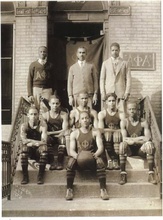
Van DerZee chronicled Harlem between 1920 and 1940. He edited his photos to best show his sitters.
From: Guy C. McElroy et al.. African - American Artists : 1880 - 1987. University of Washington Press : Seattle, Washington, 1989, 44.
Laura Wheeler Waring (1887 - 1948) "Anne Washington Derry," Oil on canvas 1927
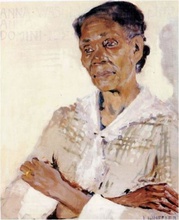
She attended the Pennsylvania Academy of Fine Arts and worked against sexism which proscribed the study of nudes of either gender by women artists. She produced socially relevant art exploring African American life.
From : Britton, Crystal A. African American Art - The Long Struggle. Todtri Productions Limited : New York, New York. 1996, 38.
Vivian Schuyler Key (1905 - 1990) Cover illustration for "The Crisis, A Record of the Darker Races," Watercolor wash February 19
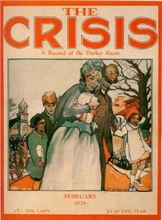
"The Crisis, A Record of the Darker Races."
Key could not find work after graduating from the Pratt Institute in 1926 as a fine artist, so she went into painting fabrics and giftware. She also designed covers for Crisis.
From: Britton, Crystal A. African American Art - The Long Struggle. Todtri Productions Limited : New York, New York. 1996, 47.
Current online issue of The Crisis
permission pending
James Lesesne Wells (1902) "The Flight Into Egypt," Oil on canvas 1930
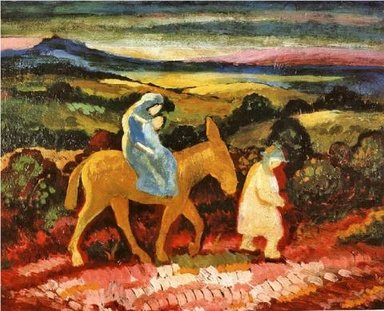
Wells favored religious subjects. He studied spiritually charged traditional African sculpture and German expressionist artists.
From: Britton, Crystal A. African American Art - The Long Struggle. Todtri Productions Limited : New York, New York. 1996, 58.
Dox Thrash ( 1892 - 1965 ) "Miss X," 1930
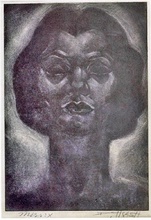
Thrash was a well-known printmaker and coinventor of the Carborundum printing process. He was the head of the Philadelphia graphics division of the WPA from 1934 - 1942. His lithographic technique was combined with a soft ground made from carbon and silicon crystals, which made velvety textures and rich tonal variations much faster than mezzotint processes. As a social realist (like Catlett), Thrash addressed themes of industry and labor as well as rendering naturalistic portraits and rural scenes.
From: Barnwell, Andrea D. The Walter O. Evans Collection of African American Art. University of Washington Press : Seattle, Washington, 1999, 143.
James A. Porter (1905 - 1970), "Woman Holding a Jug" Oil on canvas 1932
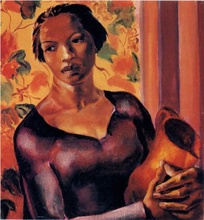
Porter wrote "Modern Negro Art" in 1943 as well as several articles on African American art and artists. This image won the Harmon Foundation's 1933 Portrait award.
From: Britton, Crystal A. African American Art - The Long Struggle. Todtri Productions Limited : New York, New York. 1996, 38.
James Lesesne Wells (1902), "Escape of the Spies from Canaan," Linoleum Cut print 1933
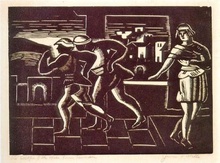
Wells favored religious subjects. He studied spiritually charged traditional African sculpture and German expressionist artists.
From : Guy C. McElroy et al. African - American Artists : 1880 - 1987. University of Washington Press : Seattle, Washington, 1989, 51.
Aaron Douglas (1899 - 1979), "Aspects of Negro Life: Song of the Towers" 1934
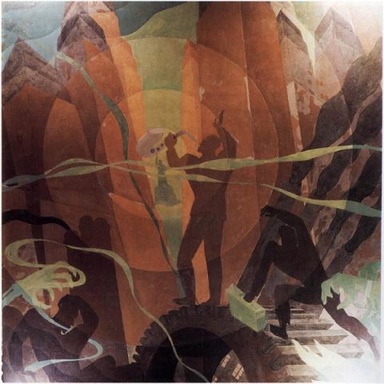
See also: Aaron Douglas standing in front of his mural
Douglas was an artist of the "Negro Renaissance Period." He used Art Deco styles learned from Winold Reiss. He was also a socialist and had labor union sympathies. He was a member of the Harlem Artists Guild, the African American artist's alternative to the Artist's Union.
From: Patton, Sharon F. Oxford History of Art - African-American Art. Oxford University Press : New York, 1998, 142.
Other works
The Art Institute of Chicago
Howard University Collection
Howard University Collection
Howard University Collection
Longer biographical sketch
Charles Alston (1907 - 1977), "The Blue Shirt," Oil on Canvas 1935
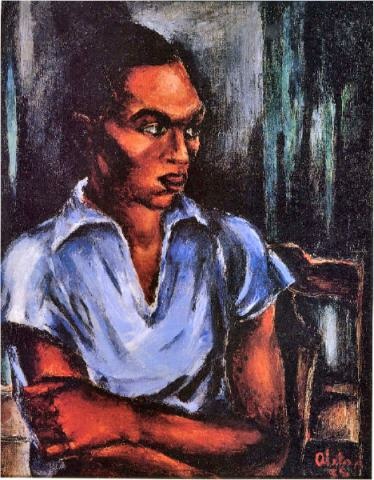
Alston was the director of the Harlem Art Workshop in 1932, and the director of the WPA Harlem Mural project, which made the first public positive representation of African Americans in two murals at Harlem Hospital in 1937.
From: Coker, Gylbert. "Nineteenth - Century African American Art" The Harmon and Harriet Kelley Collection of African American Art. The University of Texas Press : Texas, 1994, 21.
Note: Harmon and Harriet Kelley have demanded that we not display an image of any paintings they own. However, other paintings by Charles Alston can be viewed at The Journal of Antiques and his 1939 portrait can be seen at the Smithsonian WPA Photo collection
Hale A. Woodruff ( 1900 - 1980 ), "Landscape" Oil on canvas 1936
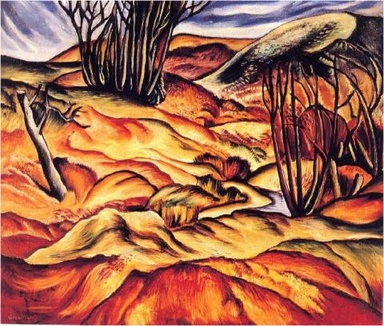
In the 1930s and 1940s American landscape and common folk were believed to be proper subjects for authentic American art. In 1936, Woodruff (who had studied the post-impressionists and Mexican muralists) embraced an art devoted almost completely to black share croppers, vernacular architecture, and Georgia landscapes.
From: Guy C. McElroy et al.. African - American Artists : 1880 - 1987. University of Washington Press: Seattle, Washington, 1989, 65.
Returning Home (Howard University)
Bridge near Avalon, France (Howard U)
Aaron Douglas ( 1899 - 1979 ), "Aspiration" Oil on canvas 1936
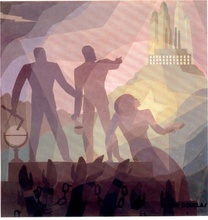
From: Guy C. McElroy et al.. African - American Artists : 1880 - 1987. University of Washington Press: Seattle, Washington, 1989, 52.
Jacob Lawrence ( 1917 ), "Iceman" 1936
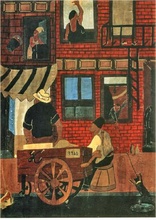
Lawrence grew up in Harlem and was introduced to art in classes by Charles Alston at the Harlem Art Workshop.
From: Barnwell, Andrea D. The Walter O. Evans Collection of African American Art. University of Washington Press: Seattle, Washington, 1999, 114.
Norman Lewis ( 1909 - 1979 ), "Yellow Hat" 1936 larger view
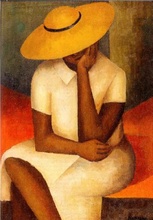
Lewis painted early in his career. He organized groups to help other African American artists with stylistic ideas.
From: Patton, Sharon F. Oxford History of Art - African-American Art. Oxford University Press : New York, 1998, 230.
Charles Alston (1907 - 1977) "Modern Medicine" 1937

This image shows the influence of the Mexican muralist, Diego Rivera, in the compact compartmental and hierarchical grouping of figures, disregard for spatial perspective, and careful delineation of form. This mural was installed in the Harlem Hospital.
From: Patton, Sharon F. Oxford History of Art - African-American Art. Oxford University Press: New York, 1998, 143.
Aaron Douglas ( 1899 - 1979 ), "Boy with Toy Plane" 1938
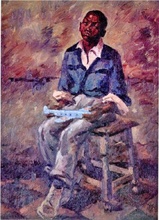
Douglas drew illustrations for Crisis and Opportunity. He was the foremost painter and muralist of Harlem Renaissance.
From: Barnwell, Andrea D. The Walter O. Evans Collection of African American Art. University of Washington Press: Seattle, Washington, 1999, 96.
Eldzier Cortor (1916), "The Night Letter" 1938
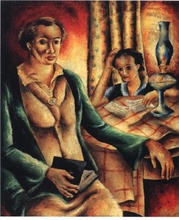
Cortor took night classes at School of Art Institute of Chicago, intent on becoming a cartoonist, and became a full-time student in 1935. He was first exposed to African art in a class trip to nearby Field Museum. He worked in the WPA in 1937, and was celebrated for painting elongated, sensual black female nudes.
From: Barnwell, Andrea D. The Walter O. Evans Collection of African American Art. University of Washington Press: Seattle, Washington, 1999, 90.
Bill Traylor ( 1856 - 1949 ), "untitled" ( Anthropomorphic Figure and Cat ), Pencil on Paper 1938 - 1943
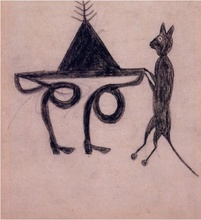
Traylor was born into slavery on Alabama plantation. He started drawing at age 85 in 1939, and his spontaneous drawings show a narrative of his life.
From: Guy C. McElroy et al. African - American Artists : 1880 - 1987. University of Washington Press : Seattle, Washington, 1989, 62.
Bill Traylor ( 1856 - 1949 ), "Man and Large Dog" Pencil and Gouache on Paper 1939 - 1942
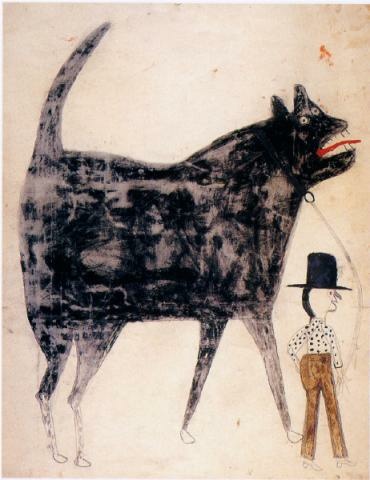
Traylor was born into slavery on Alabama plantation and started drawing at age 85 in 1939. His spontaneous drawings provide a narrative of his life.
From: Britton, Crystal A. African American Art - The Long Struggle. Todtri Productions Limited: New York, New York. 1996, 35.
Other works
High Museum of Art
Milwaukee Art Museum
Woman with Purse
Morris Museum of Art
Charles White ( 1918 - 1979 ), "Sojourner Truth" 1940
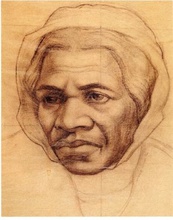
The pinprick-like marks (for example, around her mouth) and the squares on this image occurred when it was transferred for painting a mural called "Five Great American Negroes." The people shown in the mural, including Sojourner Truth, were selected in a newspaper survey by the Chicago Defender (56).
From: Barnwell, Andrea D. The Walter O. Evans Collection of African American Art. University of Washington Press: Seattle, Washington, 1999, 147.
Charles Sallee Jr., "Girl with Pink Geranium" Oil on canvas 1940
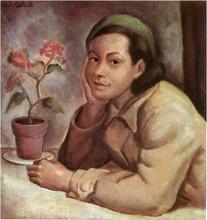
View image at AskArt
Note: Harmon and Harriet Kelley have demanded that we not show images of any paintings they own.
From: The Harmon and Harriet Kelley Collection of African American Art. The University of Texas Press: Texas, 1994, 49.
William H. Johnson ( 1901 - 1970 ), "Going to Church" 1940 - 1941
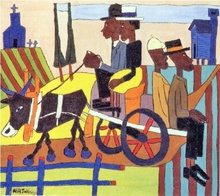
Johnson was a Primitivist painter who painted several murals for the Harmon Foundation. He severed ties from the foundation in 1946, and was later found destitute in Oslo, Norway. He was helped by the director of the foundation, but never painted again.
From: Patton, Sharon F. Oxford History of Art - African-American Art. Oxford University Press: New York, 1998, 153.
Biography and more paintings at The North by South Website
Source: The North by South
See Also: Self Portrait with Pipe
Horace Pippin ( 1888 - 1946 ), "John Brown Going to his Hanging" 1942
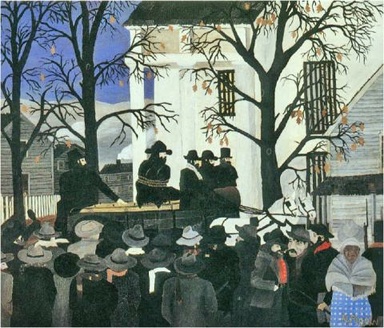
Pippin was a native of Pennsylvania and lived there most of his life. He fought in the 369th Infantry Regiment in World War I. A wound immobilized his right arm, but despite this fact he taught himself to paint. He burned images in wood with a hot poker, and then painted them with oils. This print is based on his mother's description of the scene.
From: Patton, Sharon F. Oxford History of Art - African-American Art. Oxford University Press: New York, 1998, 134.
Other works by Horace Pippin on view at AskArt
Hughie Lee - Smith (1914 - 1999), "Landscape" 1947
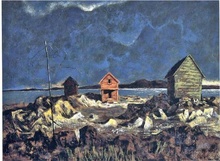
Lee-Smith was elected to National Academy of Design in 1967, the first African American elected to that post since Henry Ossawa Tanner in 1927. His art focused on the uncertainty of the future and desolate and decaying landscapes.
From: Barnwell, Andrea D. The Walter O. Evans Collection of African American Art. University of Washington Press: Seattle, Washington, 1999, 127.
Clementine Hunter ( 1885 - 1988 ), "The Pole Watchers"
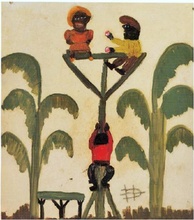
Oil on cardboard 1948
A self-taught artist, Hunter picked cotton most of her life.
From: Guy C. McElroy et al.. African - American Artists : 1880 - 1987. University of Washington Press: Seattle, Washington, 1989, 64.
Marion Perkins ( 1908 - 1961 ), "Figure Sitting" 1939
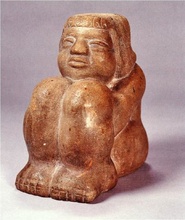
Perkins never received recognition for his art in his lifetime, but his legacy to Chicago and art is undeniable (160). He worked as a janitor, dishwasher, and dockhand as well as selling newspapers to support his art. Cofounder and instructor at the South Side Community Art center in Chicago, he helped forge a community of artists there including Eldzier Cortor, Margaret Burroughs, and Charles White.
From: Barnwell, Andrea D. The Walter O. Evans Collection of African American Art. University of Washington Press: Seattle, Washington, 1999, 134.
Marion Perkins ( 1908 - 1961 ), "The Kiss," Marble 1948
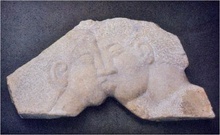
Influenced by the tenets of the Harlem Renaissance, Perkins looked to African art for direction.
From : Britton, Crystal A. African American Art - The Long Struggle. Todtri Productions Limited : New York, New York. 1996, 31.
Norman Lewis, "Harlem Courtyard" 1954
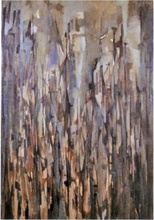
This is an example of Abstract Expressionism, a kind of "action painting" considered a uniquely American art form (173). It consisted of the spontaneous application of paint to canvas to show a particular moment. Lewis moved quickly to adopt the style. It was, for him, a way to communicate the content of a non-representational image to the public. The criss-cross lines evoke streets.
From: Patton, Sharon F. Oxford History of Art - African-American Art. Oxford University Press : New York, 1998, 174.
Norman Lewis, "Harlem Turns White" 1955
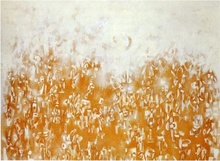
See above.
From: Patton, Sharon F. Oxford History of Art - African-American Art. Oxford University Press : New York, 1998, 174.
Hughie Lee-Smith (1914), "Reflection" Oil on Canvas 1957
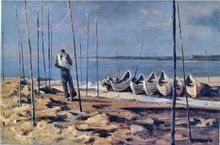
Much of Lee-Smith's work shows a black figure set in a barren inner city. In his works the city was a metaphor for the isolation and apathy of the ghetto.
From: Guy C. McElroy et al.. African - American Artists : 1880 - 1987. University of Washington Press : Seattle, Washington, 1989, 80.
Margaret Burroughs (1917 ), "Girl Seated" 1959
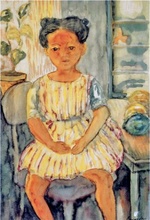
Burroughs moved to Chicago in 1922. She evoked themes of family, community and history in her paintings, sculptures and prints. Burroughs was the cofounder of the DuSable Museum of African American History in Chicago.
From: Barnwell, Andrea D. The Walter O. Evans Collection of African American Art. University of Washington Press: Seattle, Washington, 1999, 87.
Clementine Hunter ( 1885 - 1988 ), "Zinnias in a Pot"1965
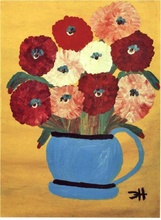
There were three broad themes in Hunter's work - work, play, and religion. She painted anything she could find - cardboard boxes, soap cartons, brown paper bags, lumbar, scraps of plywood, window shades, glass bottles, plastic milk jugs, cast iron pots, paperboard, and canvas board. Hunter had no formal training. She sold her paintings for as little as 25 cents, but in the 1980s her paintings were fetching thousands of dollars.
From: Barnwell, Andrea D. The Walter O. Evans Collection of African American Art. University of Washington Press: Seattle, Washington, 1999, 110.
Minnie Evans ( 1892 - 1987 ), "Untitled" 1945 - 1967
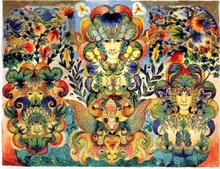
Evans felt compelled to draw on Good Friday of 1935. She said "I had a dream, its voice spoke to me: ‘Why don't you draw or die?' ‘Is that it?,' I said, ‘My, My.'" (229) She started with drawings, paused for five years, and then began watercolors in the 1940s. She usually painted gardens and omnipresent faces, most often of women.
From: Patton, Sharon F. Oxford History of Art - African-American Art. Oxford University Press: New York, 1998, 230.
Minnie Evans ( 1892 - 1987 ), "Design Made at Airlie Gardens" Oil and Mixed media on canvas 1967
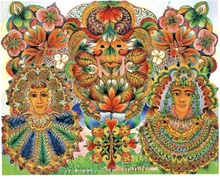
From : Britton, Crystal A. African American Art - The Long Struggle. Todtri Productions Limited : New York, New York. 1996, 92.
Elizabeth Catlett (1915), "Sharecropper" Woodcut 1970
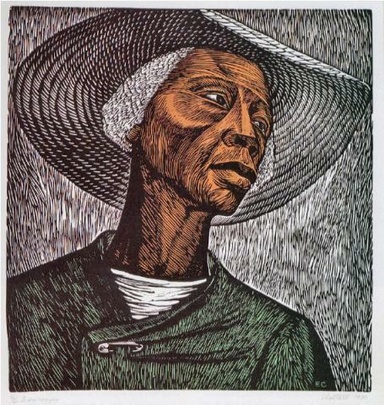
larger view at the Art Institute of Chicago
Catlett attended the University of Iowa, where she exhibited her drawings. Much like Charles White, Catlett had an interest in the human figure, showing a sense of pride and dignity. She was primarily a sculptor but also made prints such as this one.
From: Guy C. McElroy et al.. African - American Artists : 1880 - 1987. University of Washington Press: Seattle, Washington, 1989, 83.
Other works
Smithsonian American Art Museum
Selma Burke ( 1901 - 1995 ), "Peace" Italian alabaster 1972
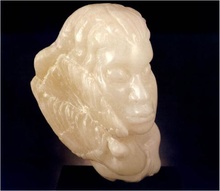
Burke made expressionistic sculptures from wood and stone. Her profile of President Franklin Delanor Roosevelt was used on the dime in 1945.
From: Britton, Crystal A. African American Art - The Long Struggle. Todtri Productions Limited: New York, New York. 1996, 12.
Malkia Roberts ( 1923 ), "Spectrum" Acrylic on canvas 1972
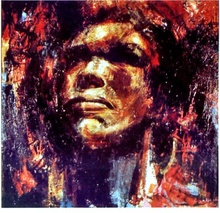
This image, according to the artist, represents acceptance of the present and anticipation of the future. The woman is the past, and the Expressionistic style and upward gaze symbolize the future. The flame-like palette "eliminates the possibility of negative space and ensuing objectivity" (203).
From: Henkes, Robert. The Art of Black American Women - Works of Twenty - Four Artists of the Twentieth Century. McFarland & Company Inc. Publishers : Jefferson, North Carolina, 1993,147.
Romare Bearden (1912 - 1988), "The Magic Garden" Collage on board 1978
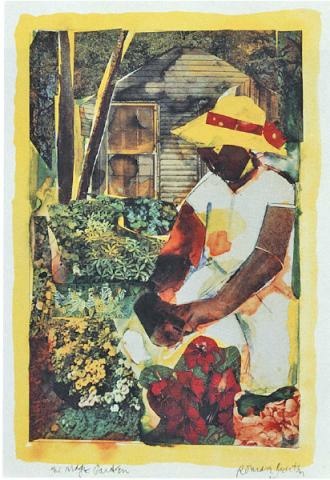
Born in Charlotte, North Carolina, Bearden moved to Harlem as a young child. He served in the army from 1942 to 1945 and traveled to Paris. Known for his revolutionary use of collage and photomontage, Beardon was a founding member of "Spiral," a group promoting civil rights in the visual arts.
From: Barnwell, Andrea D. The Walter O. Evans Collection of African American Art. University of Washington Press: Seattle, Washington, 1999, 80.
Other works
National Gallery of Art
The Art Institute of Chicago
Smithsonian American Art Museum
Metropolitan Museum of Art
A Graphic Odyssey: Romare Bearden as Printmaker Arthur Ross Gallery, U. of Penn.
Hirshhorn Museum
Charles White (1918 - 1979), "Sound of Silence" Lithograph 1978
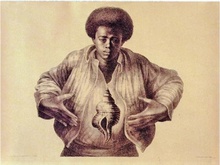
White portrayed African Americans with "poignancy and dignity rarely seen in American art" of the time (78). The image of African Americans was a symbol of racial and cultural pride.
From : Guy C. McElroy et al.. African - American Artists : 1880 - 1987. University of Washington Press : Seattle, Washington, 1989, 82.
Elizabeth Catlett (1915), "Seated Figure" Mahogany wood 1979
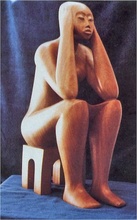
Catlett was also noted for her lithographs.
From : Henkes, Robert. The Art of Black American Women - Works of Twenty - Four Artists of the Twentieth Century. McFarland & Company Inc. Publishers : Jefferson, North Carolina, 1993,144.
William S. Carter ( 1909 ) "Woman Thinking" Oil on canvas 1981
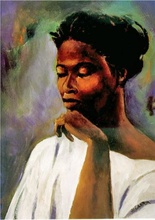
Carter worked in the WPA 1930's-1940's.
From: The Walter O. Evans Collection of African American Art. Typocraft: Detroit, Michigan, 1991, 79.
Melvin Edwards (1937), "Gate of Ogun" 1983

Ogun is the deity of iron and war found among the Yoruba, Bini, and Fon people of West Africa. Ogun lives in the flames of the blacksmith's forge, on the battlefield, and is felt in the cutting edge of iron. The burnishing (the line-like strokes from polishing) gives the appearance of brushstrokes. The gate is "a symbol of transition representing the Middle Passage and spiritual transformation" (207).
The chain-like shape both evokes slavery and, for the artist, is also a symbol of connections, chains of love, and cultural linkages (206).
From: Patton, Sharon F. Oxford History of Art - African-American Art. Oxford University Press : New York, 1998, 206.
Elizabeth Catlett ( 1915 ), "Homage to Black Woman Poets" Mahogany 1984

Born in Washington D.C., Catlett lived and worked in Mexico. She frequently uses the female form and conveys principles of Social Realism.
From: Barnwell, Andrea D. The Walter O. Evans Collection of African American Art. University of Washington Press: Seattle, Washington, 1999, 89.
Norma Morgan (1928), "Friends and Sisters" Watercolor 1984
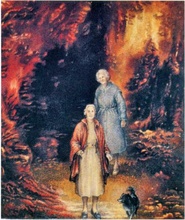
Born in Connecticut and socially active, Morgan was a magic realist artist.
From: Henkes, Robert. The Art of Black American Women - Works of Twenty - Four Artists of the Twentieth Century. McFarland & Company Inc. Publishers : Jefferson, North Carolina, 1993,147.
Viola Burley Leak (1944), "Field Trilogy" Mixed Fabric 1985
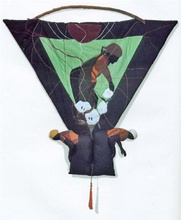
Leak presents scenes of black experience sewn into a wide array of fabric media. Her other works include "Sunday Sunder," which evokes the Birmingham, Alabama church bombing, and "Descendents," which focuses on a stately female ancestor and others to show the survival and strength of African American traditions.
From: Hall, Robert J. Gathered Visions - Selected Works by African American Women Artists. Smithsonian Institution Press : Washington, D.C. 1992, 12.
Christian Walker, "Miscegenation" Photograph 1985 - 1988
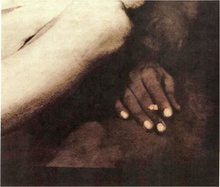
One of 15 images in the series. Black and white figures intertwine with neither gender nor context obvious. It seems oddly titled--could the title be sardonic?
From: Patton, Sharon F. Oxford History of Art - African-American Art. Oxford University Press: New York, 1998, 268.
Malkia Roberts ( 1923 ), "Guardian" Oil and Acrylic on canvas 1986
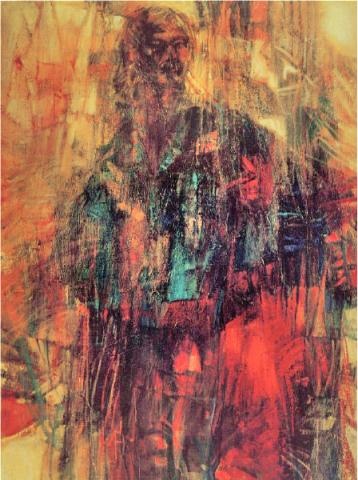
Human figures are often found in her art, but abstracted. Roberts' theme is "women of color" and how they are "protectors of family and tradition." She is quoted as saying, "My ‘gathered visions' are evoked and implied rather than realistically delineated in the traditional sense. They have evolved and are wedded in patterns of light and color, reflecting my emotional and spiritual reactions to places and ‘people of color' around the planet, with whom I have bonded. The energy invites viewers to unravel the themes and come to their own conclusions."
From: Hall, Robert J. Gathered Visions - Selected Works by African American Women Artists. Smithsonian Institution Press : Washington, D.C. 1992, 19.
John Anansa Thomas Biggers (1924-2001), "Starry Crown" Acrylic on canvas 1987
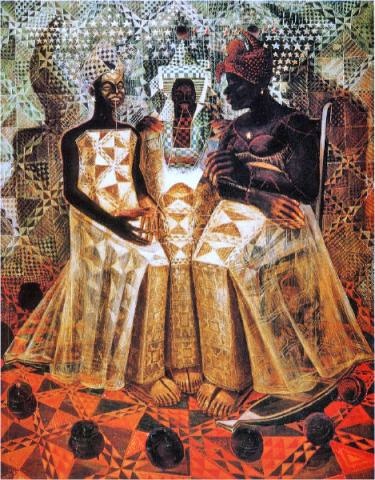
"Starry Crown" is the name of a traditional spiritual, but it also refers to the headdresses of the women, "crowns of their cultural glory." Biggers traveled to Africa to study its culture and traditions, and also collected African American Art.
From: Britton, Crystal A. African American Art - The Long Struggle. Todtri Productions Limited : New York, New York. 1996, 91.
Other works
Smithsonian American Art Museum
very large version of "Shotgun"
Lorna Simpson ( 1960 ), "Guarded Conditions," 1989
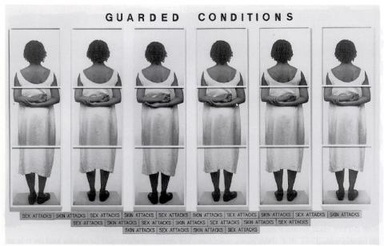
Simpson was the first African American woman to have a solo show in the Museum of Modern Art. Simpson's work focuses upon identity and authenticity and usually uses an African American female form.
From: Patton, Sharon F. Oxford History of Art - African-American Art. Oxford University Press : New York, 1998, 266.
Faith Ringgold, "Change: Faith Ringgold's Over 100 lbs Weight Loss Performance Story Quilt," Fabric 1986
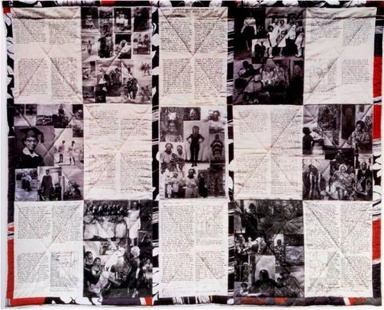
Thalia Goumand-Peterson describes a performance of "Change":
During the performance Ringgold, dressed in a quilted jacket identical to the quilt reenacts her "Over 100 Pound Weight Loss" by reciting the text of the quilt. She emerges into the room dragging a big, black garbage bag (filled with two-litre plastic bottles of water) which looks like a human body and is equal to the amount of weight to the amount she lost, and she is hardly able to move. At various points through the performance she returns to the bag and tries to move it, but to no avail. Both at the beginning and the end, as Ringgold intones, "I can do it, I can change, I can change. Now", the audience is invited to join her in dance to the rhythms of "Only the Strong Survive". The finale is marked by the removal of the quilted jacket and Ringgold's emergence as she is now, as she has recreated herself as a Black activist, feminist, contemporary American artist whose art speaks with an authoritative female voice. (244)
From: Patton, Sharon F. Oxford History of Art - African-American Art. Oxford University Press: New York, 1998, 245.
Faith Ringgold ( 1930 ) "Subway Graffiti #3," Acrylic on canvas, Pieced fabric 1987
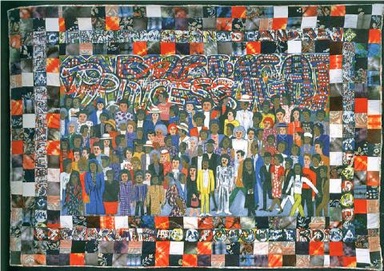
From: Cameron, Dan et al. Faith Ringgold's French Collection and Other Story Quilts - Dancing at the Louvre. University of California Press : Berkeley, California, 1998, 86.
permission pending
Faith Ringgold ( 1930 ) Sketch for "Dancing at the Louvre"Color Marker on paper 1990
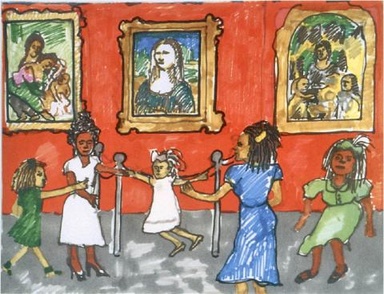
Partial text from the quilt (see finished image for the rest):
Dear Aunt Melissa,
Marcia and her three little girls took me dancing at the Louvre. I thought I was taking them to see the Mona Lisa. You've never seen anything like this. Well, the French hadn't either. Never mind Leonardo da Vinci and Mona Lisa, Marcia and her three girls were the show.
2 They ran me ragged. Marcia wanted to go one way and the children another. The baby girl wanted to jump. The other two wanted to run, and did. Then they all just broke into a dance when we finally found the Mona Lisa.
3 Pierre used to say "Cherchez le fauteuil roulant, just get a wheelchair at the door of the Louvre, ‘cause if you don't you're gonna need one going home." I've been to the Louvre a hundred times, but never have I seen it like this. It was like looking at all the pictures upside down from a racing car going 100 kilometres a l'heure. (129)
From: Cameron, Dan et al. Faith Ringgold's French Collection and Other Story Quilts - Dancing at the Louvre. University of California Press : Berkeley, California, 1998, 125.
permission pending
Faith Ringgold (1930 ) "Dancing at the Louvre," Acrylic on Canvas 1991
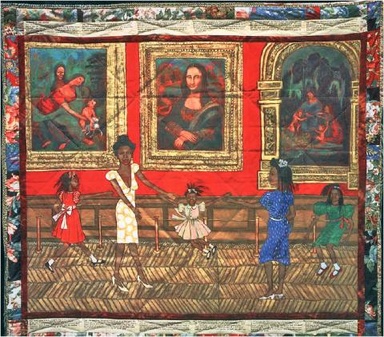
Partial text from quilt (continued from sketch):
4 Now that Marcia is married to Maurice, and they have moved to Paris, she and her children are determined to speak le bon Francais parfaitement by morning. I had to put her straight about me and the children. You know how it is with friends, they all want to tell you whom they think you are and how to live your life, and why.
5 Well I told her straight out, "Marcia, you know damn good and well your papa never went past the third grade." And that was good in those days, ‘cause he wasn't supposed to do that. But my papa was a school principal. He finished Lincoln Academy in Lynnsville. And I got the diploma to prove it.
6 Papa taught in Florida, South Carolina, and Georgia. I got all his licenses and test scores. Papa and Mama was both teachers. We didn't come up like no weeds. Not saying she did either. But I resent her telling me that my children belong in France. And that I should be raising them, not you.
7 Papa never allowed those Campbell boys in our yard. Chauncey, Buba, and Percy, none of Marcia's brothers was allowed in our yard. Now I'm not saying he was right ‘cause Papa, etait un snob. But I remember Papa, in that little pinstriped coat he used to wear and his glasses on the end of his nose.
8 Papa was something. "No, young man, you go out of this yard. The Simone girls are doing their chores and they have their studies, supper and to bed. Allez vous en!" then he'd hit that tail at the back of his coat like a period and turn at the same time. And those Campbell boys would fly out of our yard.
9 Papa wasn't too keen on Marcia either, but she always had a little way about her, like she thought she was tres chic. Marcia doesn't remember any thing about growing up poor in Atlanta. As far as she is concerned she was born in a first class cabin on the S.S. Liberte on her way to Paris, sipping Moet and smoking a Gauloise.
10 You should hear the story she told us about how she used to set the table for dinner with silver service and cristal every night ‘cause her father would get upset if he came home and the table wasn't formally set for supper. We were at a Paris party and her husband, Maurice, was present so I just "uh-uh'd" her.
11 But I remember the time we saw those Campbell boys coming out of Miss Baker's back door carrying food. They said they were cleaning out her ice box and the food was spoiled. Then Miss Baker came over crying to Papa that all the food in her ice box was gone. Papa sat Miss Baker down to our supper table and went straight over to Marcia's house.
12 And there was Mr. and Mrs. Campbell, and their three sons sitting at their kitchen table in the dark eating Miss Baker's food. When Papa came in they started coughing and gagging. They almost choked. But not Mademoiselle Marcia. Papa said she was on the back porch nursing un cristal de limonade and reading Madame Bovary. (129 - 130)
From: Cameron, Dan et al. Faith Ringgold's French Collection and Other Story Quilts - Dancing at the Louvre. University of California Press : Berkeley, California, 1998, 93.
Faith Ringgold ( 1930 ) "The Sunflowers Quilting Bee at Arles" Acrylic on canvas Printed and Tie-dyed fabric 1991
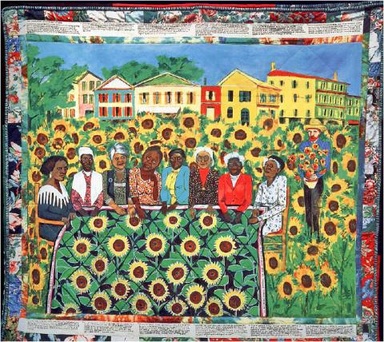
Left to right: Madame C.J. Walker (marketer of a hair straightening comb, American-born self-made millionaire), Sojourner Truth (campaigner for woman's rights and slavery), Ida B. Wells (wrote an expose of the horrors of lynching in South), Fannie Lou Hamer (registered people to vote), Harriet Tubman (Underground Railway), Rosa Parks (mother of Civil Rights movement), Mary McLeod Bethune (founded a college, advisor to Truman and F. D. Roosevelt), Ella Baker (organized people to improve housing for poor, jobs, and education), Vincent van Gogh (painter)
The story on the quilt is about the meaning of quilting in the woman's lives, whether or not Vincent belongs in the picture, what each woman did, and whether the narrator (Willia Marie) can make these women proud.
From: Cameron, Dan et al. Faith Ringgold's French Collection and Other Story Quilts - Dancing at the Louvre. University of California Press : Berkeley, California, 1998, 99.
Faith Ringgold ( 1930 ) "Moroccan Holiday" Acrylic on canvas 1997
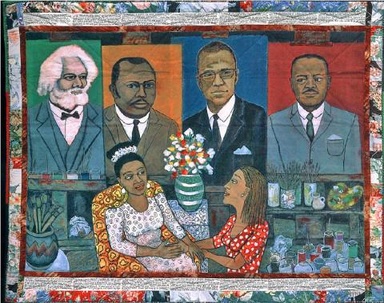
First text block :
Being here with you Marlena, my darling daughter, is a true Moroccan holiday. I have just completed these paintings of four great men in our history. A gift for you, my love, to celebrate our women's courage. Had I been born a man I would have been just like them. It is their courage that will not allow me to be a victim, Marlena. Never be a victim, Marlena. Never never, Marlena. (143)
From: Cameron, Dan et al. Faith Ringgold's French Collection and Other Story Quilts - Dancing at the Louvre. University of California Press : Berkeley, California, 1998, 115.
Jacob Lawrence ( 1917 ) "Genesis Creation Sermon I: In the Beginning All Was Void" 1989
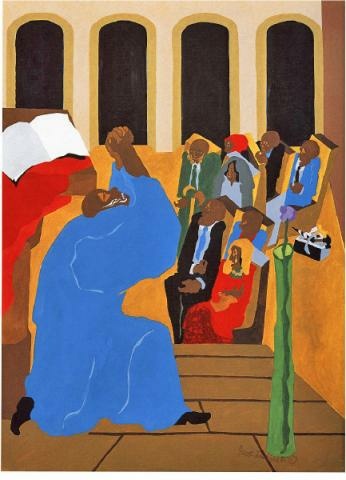
This series of paintings was based on memories of Sunday sermons by Reverend Adam Clayton Powell Sr. Powell was a pivotal figure in the development of the Abyssian Baptist Church in Harlem and was responsible for raising money to move the Church to better quarters. Powell also opened a community center, home for the aged, and soup kitchens during the depression. The toolbox in the image symbolizes how the church, in the artist's mind, served as a building block for the community. This interest in showing the power of ordinary people shows that Lawrence is still serving the goals of the Harlem Renaissance (49).
From : Barnwell, Andrea D. The Walter O. Evans Collection of African American Art. University of Washington Press : Seattle, Washington, 1999, 119.
Other paintings
National Gallery of Art
The Art Institute of Chicago
Museum of Modern Art (MoMA)
Hirshorn Museum
Portrait of Stokeley Carmichael (Kwame Ture)
Self Portrait National Portrait Gallery
Smithsonian American Art Museum
Frederick R. Weisman Art Museum
Lorna Simpson ( 1960 ) "Guarded Conditions," Polaroid photographs 1990

Simpson's work focuses upon identity and authenticity and usually uses an African American female form.
From : Britton, Crystal A. African American Art - The Long Struggle. Todtri Productions Limited : New York, New York. 1996, 83.
Emma Amos ( 1938 ) "Equals," 1992
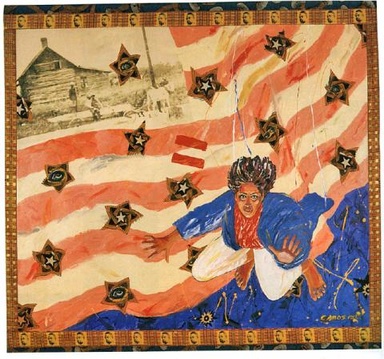
The images in the top and bottom border are of Malcolm X. The photo in the top left is a 1930s one of a woman and family. The woman is the artist.
From : Patton, Sharon F. Oxford History of Art - African-American Art. Oxford University Press : New York, 1998, 246.
Dawoud Bey ( 1953 ) "Brian and Paul" (Brian), Polaroid 1993
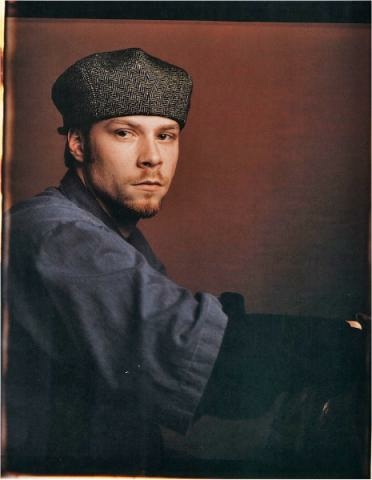
Large format Polaroid images ( 22 x 30 inch). Bey tends to photograph marginalized people to show individuality and group identity. This is a photo of two men, but since the image is split in half, one is divided.
From : Patton, Sharon F. Oxford History of Art - African-American Art. Oxford University Press : New York, 1998, 270.
Dawoud Bey ( 1953 ) "Brian and Paul" (Paul), Polaroid 1993
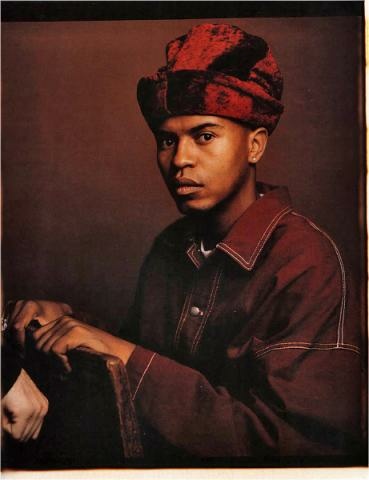
Large format Polaroid images ( 22 x 30 inch). Bey tends to photograph marginalized people to show their individuality and group identity. This is a photo of two men, but since the image is split in half, one is divided.
From : Patton, Sharon F. Oxford History of Art - African-American Art. Oxford University Press : New York, 1998, 270.
Other Collections of African American Artists' Works
The African American Artist: An Historical Perspective by Thurlow Evans-Tibbs
African-American Artists, 1929-1945 - Metropolitan Museum of Art
Selections from American Art from the Howard University Collection